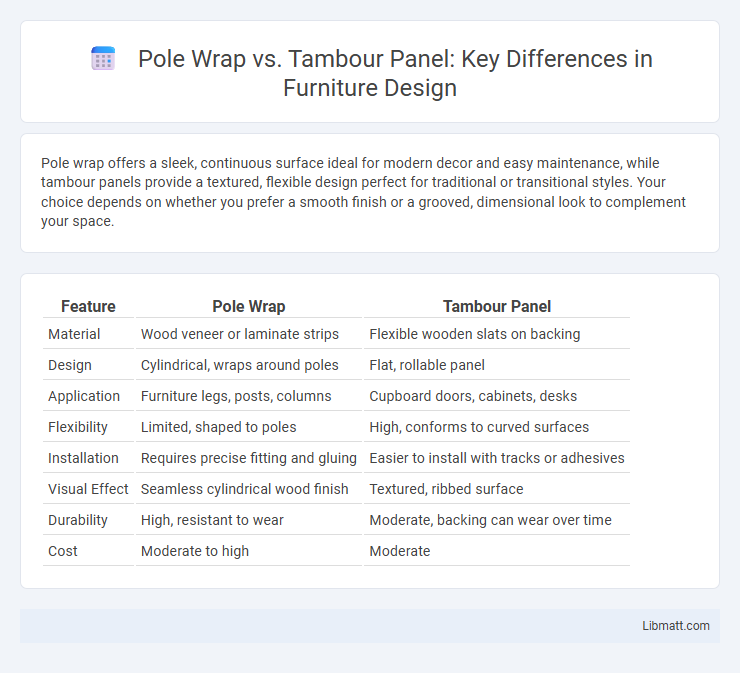Pole wrap offers a sleek, continuous surface ideal for modern decor and easy maintenance, while tambour panels provide a textured, flexible design perfect for traditional or transitional styles. Your choice depends on whether you prefer a smooth finish or a grooved, dimensional look to complement your space.
Table of Comparison
| Feature | Pole Wrap | Tambour Panel |
|---|---|---|
| Material | Wood veneer or laminate strips | Flexible wooden slats on backing |
| Design | Cylindrical, wraps around poles | Flat, rollable panel |
| Application | Furniture legs, posts, columns | Cupboard doors, cabinets, desks |
| Flexibility | Limited, shaped to poles | High, conforms to curved surfaces |
| Installation | Requires precise fitting and gluing | Easier to install with tracks or adhesives |
| Visual Effect | Seamless cylindrical wood finish | Textured, ribbed surface |
| Durability | High, resistant to wear | Moderate, backing can wear over time |
| Cost | Moderate to high | Moderate |
Introduction to Pole Wraps and Tambour Panels
Pole wraps and tambour panels are versatile design elements used to enhance the aesthetic and functional appeal of furniture and interiors. Pole wraps typically provide a sleek, protective covering around structural poles, often crafted from materials like wood, vinyl, or fabric that complement your decor. Tambour panels, characterized by their narrow, flexible slats, offer decorative shutter-like effects or sliding door functionality, delivering a distinct texture and dynamic movement to cabinets, closets, or walls.
Key Differences Between Pole Wraps and Tambour Panels
Pole wraps are decorative or protective coverings designed to encase vertical poles, typically made from materials like vinyl, fabric, or foam to provide cushioning and aesthetic appeal. Tambour panels, on the other hand, consist of narrow wooden slats connected by a flexible backing, allowing them to roll or slide smoothly for doors or furniture surfaces. While pole wraps primarily enhance safety and visibility of poles, tambour panels serve functional and design purposes in cabinetry and architectural applications, offering flexibility and intricate wood grain visuals.
Material and Construction
Pole wraps are typically constructed from flexible materials such as PVC or vinyl, designed to tightly encase structural poles and provide a smooth, impact-resistant surface. Tambour panels consist of narrow wooden slats connected by fabric or flexible backing, allowing the panel to roll or bend for doors or shutters. Both options use durable materials, but pole wraps emphasize rigidity and protection while tambour panels prioritize flexibility and aesthetic appeal.
Design Aesthetics and Style Options
Pole wrap offers a streamlined, minimalist design that seamlessly integrates with modern and contemporary interiors, emphasizing clean lines and subtle textures. Tambour panels provide a more classic, textured appearance with horizontal slats that evoke a sense of warmth and traditional craftsmanship, often available in a variety of wood finishes for enhanced stylistic versatility. Both options cater to different aesthetic preferences, with pole wraps prioritizing sleekness and tambour panels delivering rustic or mid-century charm.
Installation Process: Pole Wrap vs Tambour Panel
Pole wraps offer a straightforward installation process, often requiring minimal tools and time, as they simply wrap around existing poles or posts. Tambour panels demand more precise measurements and secure mounting, typically needing screws or tracks to ensure alignment and stability. Pole wraps are ideal for quick upgrades, while tambour panels provide a more permanent and structured finish.
Durability and Maintenance Comparison
Pole wraps offer superior durability due to their sturdy materials, which resist scratches and impacts better than tambour panels that are made from thin, flexible slats prone to wear and damage. Maintenance for pole wraps is minimal, requiring only occasional cleaning to retain their appearance, whereas tambour panels often need more frequent adjustments and can accumulate dirt in their grooves, increasing upkeep. Choosing pole wraps enhances your space's longevity and reduces maintenance efforts compared to the delicate nature of tambour panels.
Cost Comparison: Which Is More Budget-Friendly?
Pole wrap generally offers a more budget-friendly option compared to tambour panels due to its simpler installation process and lower material costs. Tambour panels, made from flexible slats of wood or composite, often require precise craftsmanship and higher-quality materials, increasing overall expenses. For projects prioritizing cost efficiency without compromising aesthetic appeal, pole wrap remains the preferred choice.
Ideal Applications for Pole Wraps
Pole wraps are ideal for cable management and decorative purposes on cylindrical structures like columns and poles in commercial and residential spaces. They provide easy installation and maintenance access compared to tambour panels, making them suitable for environments requiring frequent adjustments or repairs. Their versatility and sleek design make pole wraps perfect for organizing wiring in offices, retail stores, and entertainment venues.
Best Uses for Tambour Panels
Tambour panels, made from narrow slats of wood or aluminum, are best used for covering curved surfaces or providing flexible door solutions in furniture and cabinetry. Their smooth, retractable design makes them ideal for space-saving applications such as roll-top desks, kitchen cabinets, and entertainment centers. Unlike pole wraps, tambour panels offer a sleek, modern aesthetic while maintaining durability and ease of operation.
Choosing the Right Option for Your Project
Choosing between pole wrap and tambour panel depends on your project's design goals and installation needs. Pole wraps offer a seamless, rounded aesthetic ideal for covering vertical supports, while tambour panels provide flexible, slatted surfaces suited for curved walls or cabinetry. Understanding your spatial constraints and style preferences will help you determine which option best enhances your project's functionality and visual appeal.
Pole wrap vs tambour panel Infographic

 libmatt.com
libmatt.com